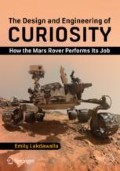Abstract
The Curiosity mission navigates Mars using a combination of human and artificial intelligence. Both methods rely upon a suite of engineering cameras for situational awareness. The twelve engineering cameras are in six pairs: two redundant pairs each of Navcams, front Hazcams, and rear Hazcams. A remote sensing mast lifts the four Navcams nearly two meters above the Martian surface, while the eight Hazcams are mounted at belly height, four facing forward and four to the rear. The Hazcams and Navcams are flight spares or build-to-print copies of the engineering cameras of the same names on the Mars Exploration Rovers; this not only saved money in hardware, but made it significantly easier to use a modified version of the same rover driving software for Curiosity as for Spirit and Opportunity. The mast also carries the Mastcams and parts of the ChemCam and REMS instruments. Both Navcams and Hazcams are routinely used to gather data for environmental science purposes.
Access this chapter
Tax calculation will be finalised at checkout
Purchases are for personal use only
REFERENCES
Alexander D and Deen R (2015) Mars Science Laboratory Project Software Interface Specification: Camera & LIBS Experiment Data Record (EDR) and Reduced Data Record (RDR) Data Products, version 3.5.
Kloos J L et al (2016) The first Martian year of cloud activity from Mars Science Laboratory (sol 0–800). Adv Space Res 57:1223–1240, DOI: 10.1016/j.asr.2015.12.040
Lemmon M T et al (2017) Dust devil activity at the Curiosity Mars rover field site. Paper presented at the 48th Lunar and Planetary Science Conference, The Woodlands, Texas, 20–24 Mar 2017
Maki J et al (2012) The Mars Science Laboratory engineering cameras. Space Sci Rev 170:77–93, DOI: 10.1007/s11214-012-9882-4
Moores J E et al (2014) Update on MSL atmospheric monitoring movies sol 100–360. Paper presented at the 45th Lunar and Planetary Science Conference, The Woodlands, Texas, 17–21 Mar 2014
Author information
Authors and Affiliations
Rights and permissions
Copyright information
© 2018 Springer International Publishing AG, part of Springer Nature
About this chapter
Cite this chapter
Lakdawalla, E. (2018). The Mast, Engineering Cameras, Navigation, and Hazard Avoidance. In: The Design and Engineering of Curiosity. Springer Praxis Books(). Springer, Cham. https://doi.org/10.1007/978-3-319-68146-7_6
Download citation
DOI: https://doi.org/10.1007/978-3-319-68146-7_6
Published:
Publisher Name: Springer, Cham
Print ISBN: 978-3-319-68144-3
Online ISBN: 978-3-319-68146-7
eBook Packages: Physics and AstronomyPhysics and Astronomy (R0)

